Georgia
Thousands Of Years Of History, Stunning Scenery, A Unique Cuisine, & Overly Hospitable Locals
Mestia, Upper Svaneti, Georgia. March 22, 2015
Boasting thousands of years of history, stunning scenery, a unique cuisine & overly hospitable locals, Georgia, in the Eurasian Caucasus straddling Europe & Asia, has so much to offer that you might need to spend more time in the country than initially planned. I did.
– Official Georgian government tourism website
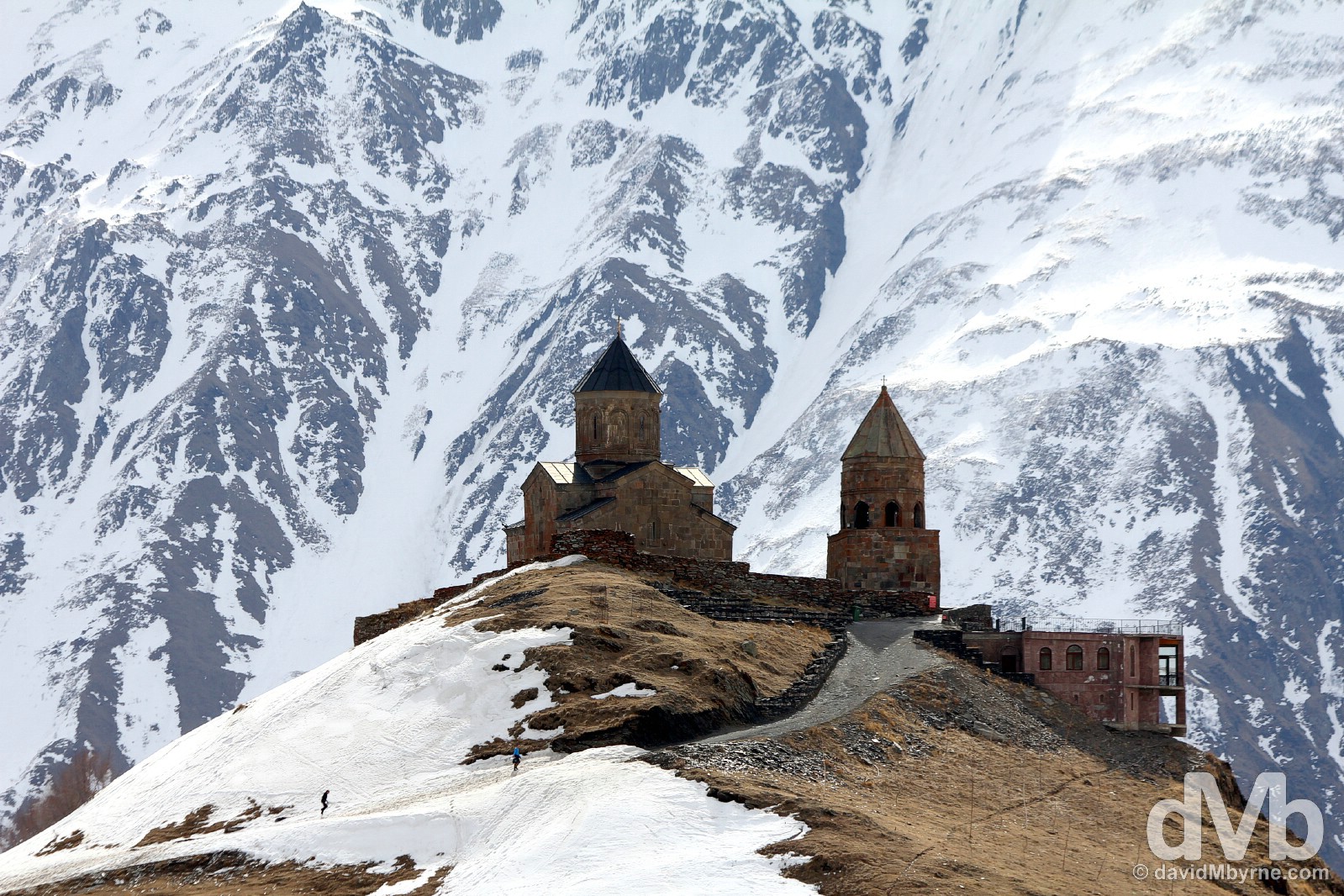
Approaching the Tsminda Sameba/Holy Trinity Church above the village of Stepantsminda in northern Georgia. March 28, 2015.
History, The People, & The Tourism Push
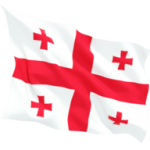 Although is was the second country in the world to officially adopt the Christian faith, doing so some 25 years after neighbouring Armenia way back in the 4th century, for much of its existence Georgia has been under Persian & Arab control; it wasn’t until the early 12th century, while under the rule of King Davit Aghmashenebeli, that the country became a centre of Christian culture & learning, not to mention a Caucasian power. The Mongols, as they tended to do, ended the good old days for the Georgians when they attacked in the 1220s. The Uzbek despot Timur (Tamerlane) was a bane too; he scourged the Georgians incessantly, attacking no less than 8 times between 1386 & 1403, a period when the country was mostly under Muslim rule. Georgia was split for the next 4 centuries until the Russians arrived in 1770 offering protection against the Muslims. Of course Russia did more than just protect – it annexed the country & ruled it for the next 200 years. The Georgians briefly tasted independence during the 1918 Russian Revolution but were absorbed into the USSR in 1922 following the latest Red Army invasion. The country suffered throughout the Soviet days even with Stalin, a Georgian born in Gori, at the helm (although the Georgian capitalist instinct & agricultural wealth saw them enjoying a higher standard of living than most others in the Soviet bloc).
Although is was the second country in the world to officially adopt the Christian faith, doing so some 25 years after neighbouring Armenia way back in the 4th century, for much of its existence Georgia has been under Persian & Arab control; it wasn’t until the early 12th century, while under the rule of King Davit Aghmashenebeli, that the country became a centre of Christian culture & learning, not to mention a Caucasian power. The Mongols, as they tended to do, ended the good old days for the Georgians when they attacked in the 1220s. The Uzbek despot Timur (Tamerlane) was a bane too; he scourged the Georgians incessantly, attacking no less than 8 times between 1386 & 1403, a period when the country was mostly under Muslim rule. Georgia was split for the next 4 centuries until the Russians arrived in 1770 offering protection against the Muslims. Of course Russia did more than just protect – it annexed the country & ruled it for the next 200 years. The Georgians briefly tasted independence during the 1918 Russian Revolution but were absorbed into the USSR in 1922 following the latest Red Army invasion. The country suffered throughout the Soviet days even with Stalin, a Georgian born in Gori, at the helm (although the Georgian capitalist instinct & agricultural wealth saw them enjoying a higher standard of living than most others in the Soviet bloc).
– Lonely Planet Georgia
Like most ex-Soviet bloc countries, Georgia declared independence in 1991 following the collapse of the USSR, which ushered in a decade of chaos in the form of civil & ethnic wars that rocked the country & brought with it terrible waves of crime, gang warfare, infrastructure collapse & rampant corruption (it was during this period that, and as a result of the 1992-1993 War in Abkhazia, Georgia lost control of 9,000 km² of its northwest, today the partially recgonised state – by Russia & a handful of others – of Abkhazia). Thankfully the dark days of the recent past seem to be just that, in the past, notwithstanding the 2008 Russo-Georgian War, widely regarded as the first European war of the 21st century, in which Georgia lost control of the 4,000 km² South Ossetia region, today another partially recgonised state in what the UN considers Georgia proper. Georgia is presently stable while seeming intent on attracting the tourist dollar. It certainly has plenty to offer. Just be warned – you might find yourself needing more time in the country than initially planned. I know I did.
Read all postings from the road in chronological order or jump to specific postings using these links.
ARRIVAL – Flight To Tbilisi & The Caucasus Mountains
THE CAPITAL – Tbilisi & Georgian Churches
THE SVAN HEARTLAND – Mestia
GEORGIAN MILITARY HIGHWAY – Kazbegi/Stepantsminda
FLIGHT TO TBILISI
Date || March 18, 2015
Location || Tbilisi, Georgia ( )
)
It was a long day today. A 4 a.m. wake-up call in Tashkent, Uzbekistan, 2 4-hour flights and a 3 hour layover in Domodedovo Airport in Moscow got me here to Tbilisi in Georgia in the Eurasian Caucasus. No, geographically I didn’t travel very far. Tashkent to Tbilisi is probably a 2 hour direct flight, were such a thing to exist. It doesn’t so I had to go around the houses. Yes, woe is me. Oh well, at least I was treated to some nice scenery en route.
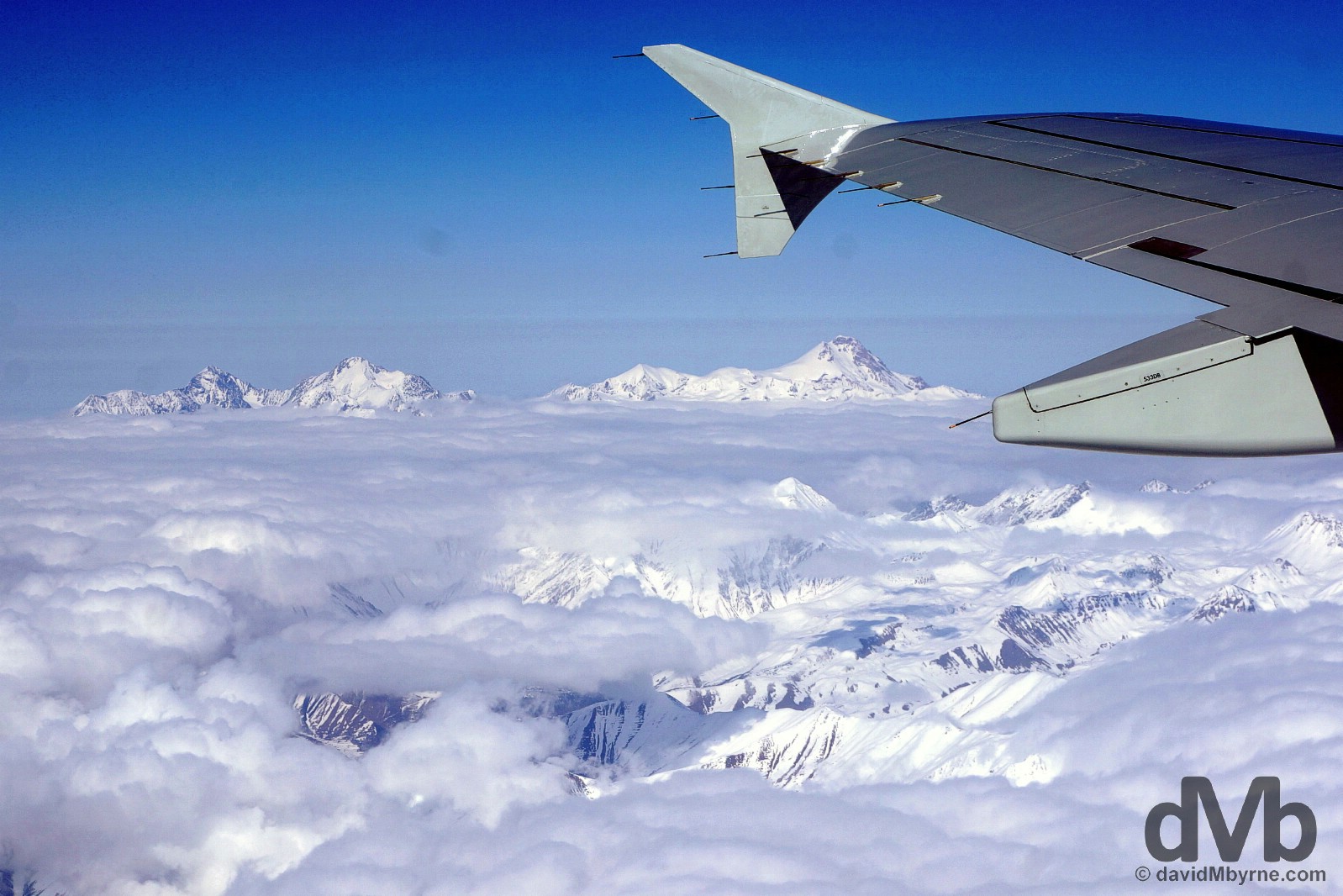
Caucasus Mountain scenery as seen today from behind the dirty windows of Siberia S7 Airlines flight 955 en route from Moscow, Russia, to Tbilisi, Georgia. The sight of massive mountain peaks piercing the cloud line was pretty special. 5,642 metre Mount Elbrus, Europe’s highest peak, is out there somewhere. It rests on the Russian side of the Russia-Georgia border somewhere, as I said, out there & somewhere I plan on exploring at closer quarters over the coming days. March 18, 2015.
Date || March 29, 2015
Location || Tbilisi, Georgia ( )
)
Wow. My time in Georgia seemed to fly by. I seemed to be constantly on the move, either heading for the hills, heading for the border with Armenia, or heading for bed exhausted. Eight nights I spent in the country, including last night, which is still tonight. What? As I type, March 29, 2015, is still in its infancy being only 90-minutes-old. It is approaching 1:30 a.m. and I’ve another 3 hours to wait for my 4:30 a.m. flight to Istanbul, Turkey. Toda… whoops, yesterday was yet another busy Georgian day & I’d like to get some sleep. But that’s not going to happen, not here in the bustling departures hall of Tbilisi’s International Airport, as nocturnal an airport as I’ve passed through in a long time. So I’m trying to stay awake by sorting through my pictures from the last week & a bit in Georgia, a country I now know has a history spanning thousands of years, a unique cuisine, hospitable locals and natural beauty that few countries on the planet earth could possibly hope to match. All in all Georgia was a surprise, and a very pleasant one at that.
TBILISI - THE CAPITAL
I left Tbilisi, the Georgian capital, quite a few times (for the Caucasus hills, for Gori, Stalin’s hometown, and for neighbouring Armenia) but I always came back. This may not be the biggest urban centre in the Caucasus but it is the region’s beating heart and its most attractive city. Also, being 10 times larger than any other Georgian city makes it the cultural, educational, economic & social centre of the country. It’s also old. According to Georgian legend, Tbilisi, nestled in the foothills of the Trialeti mountain range on either side of the Mtkvari (Kura) River, was founded in the 5th century by King Vakhtang Gorgasail. It’s an interesting place, a striking mix of unkempt, crumbling old & futuristic, shiny new.
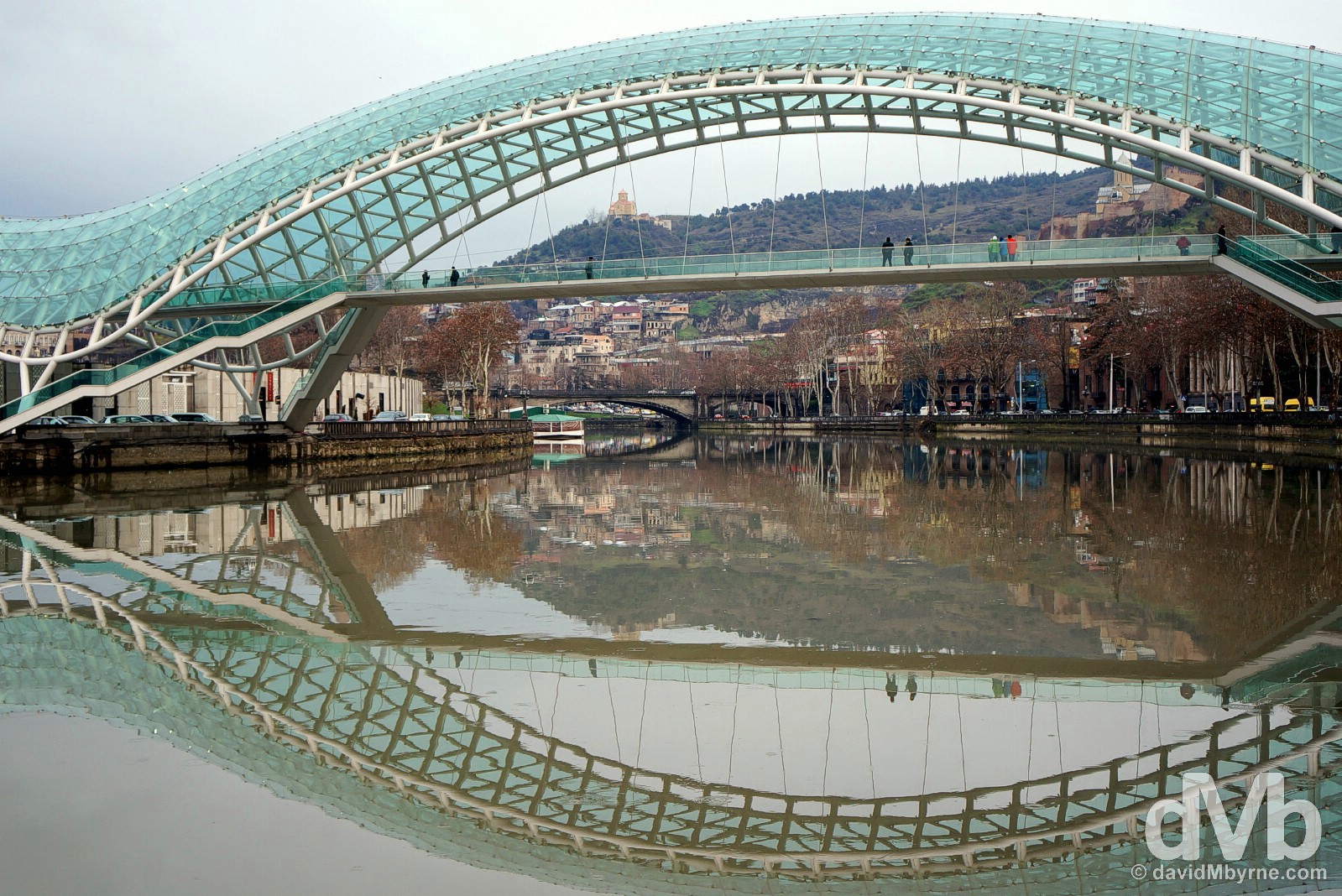
Reflections on the Kura River in Tbilisi with old Tbilisi to the right, new Tbilisi to the left. Tbilisi, Georgia. March 20, 2015.
Old Town
Tbilisi first became the capital of Georgia in the 5th Century under the then King Vakhtang Gorgasali, still today considered the father of the Georgian nation, when it was moved from nearby UNESCO-listed Mtskheta. Today the remnants of Tbilisi’s past as an ancient crossroads between Europe & Asia are on full display among the narrow, winding, cobbled lanes of leaning wooden & traditional balconied houses, caravanserais, churches, & shady squares of the city’s Old Town, from where modern-day Tbilisi grew.
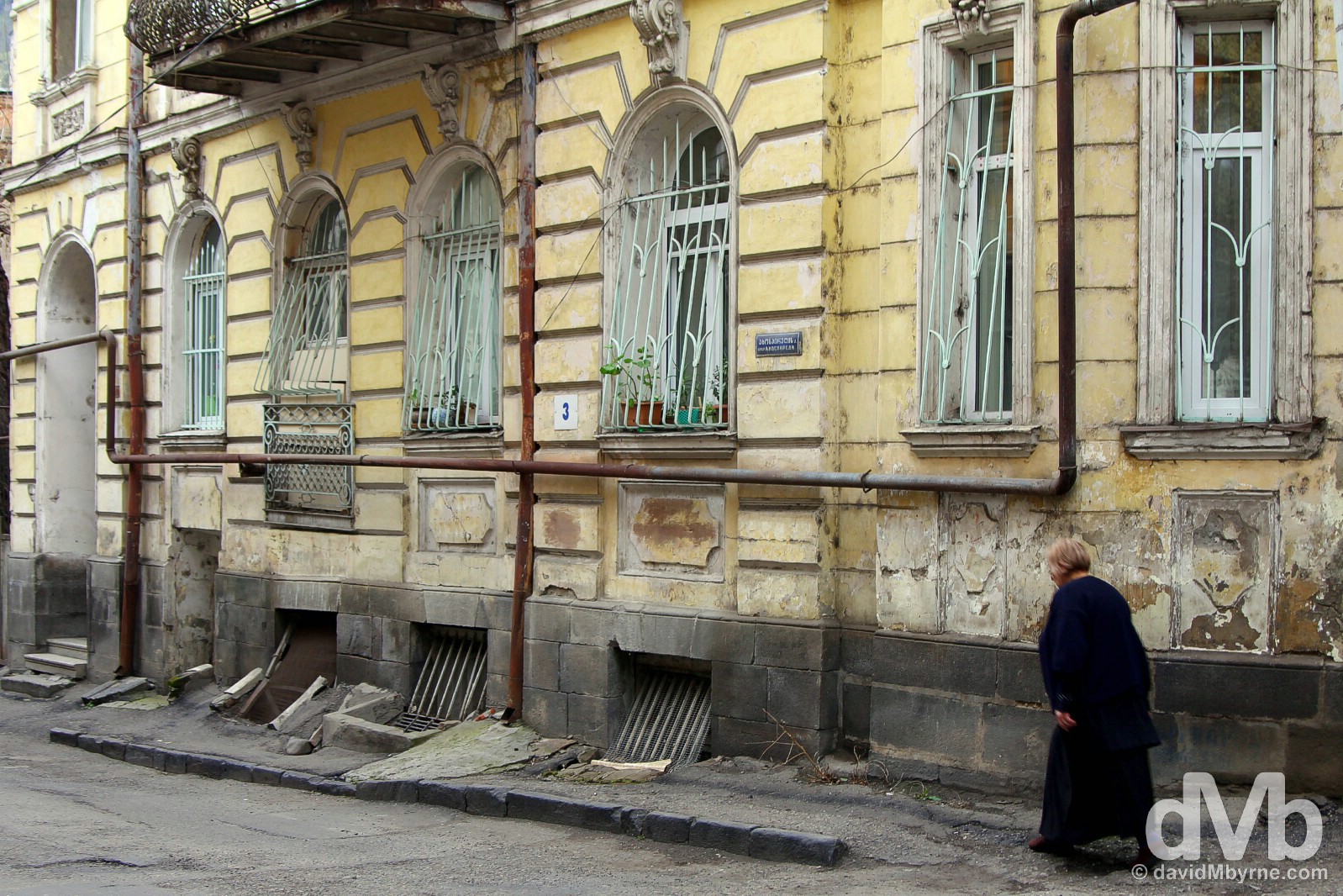
Large parts of the Old Town district have been revamped and you won’t have a hard time finding a trendy café or bar, a folksy, tourist-orientated shop, or an expensive boutique hotel. But look around the corner and you’ll probably be presented with rows of crumbling concrete with dilapidated facades lining uneven sidewalks as seen here. Old Town, Tbilisi, Georgia. March 19, 2015.
Bridge of Peace
New Tbilisi isn’t far from old Tbilisi and connecting the two is the new ultracontempory Bridge of Peace, a 150 metre-long steel & glass pedestrian bridge spanning the city’s Kura (Mtkvari) River.
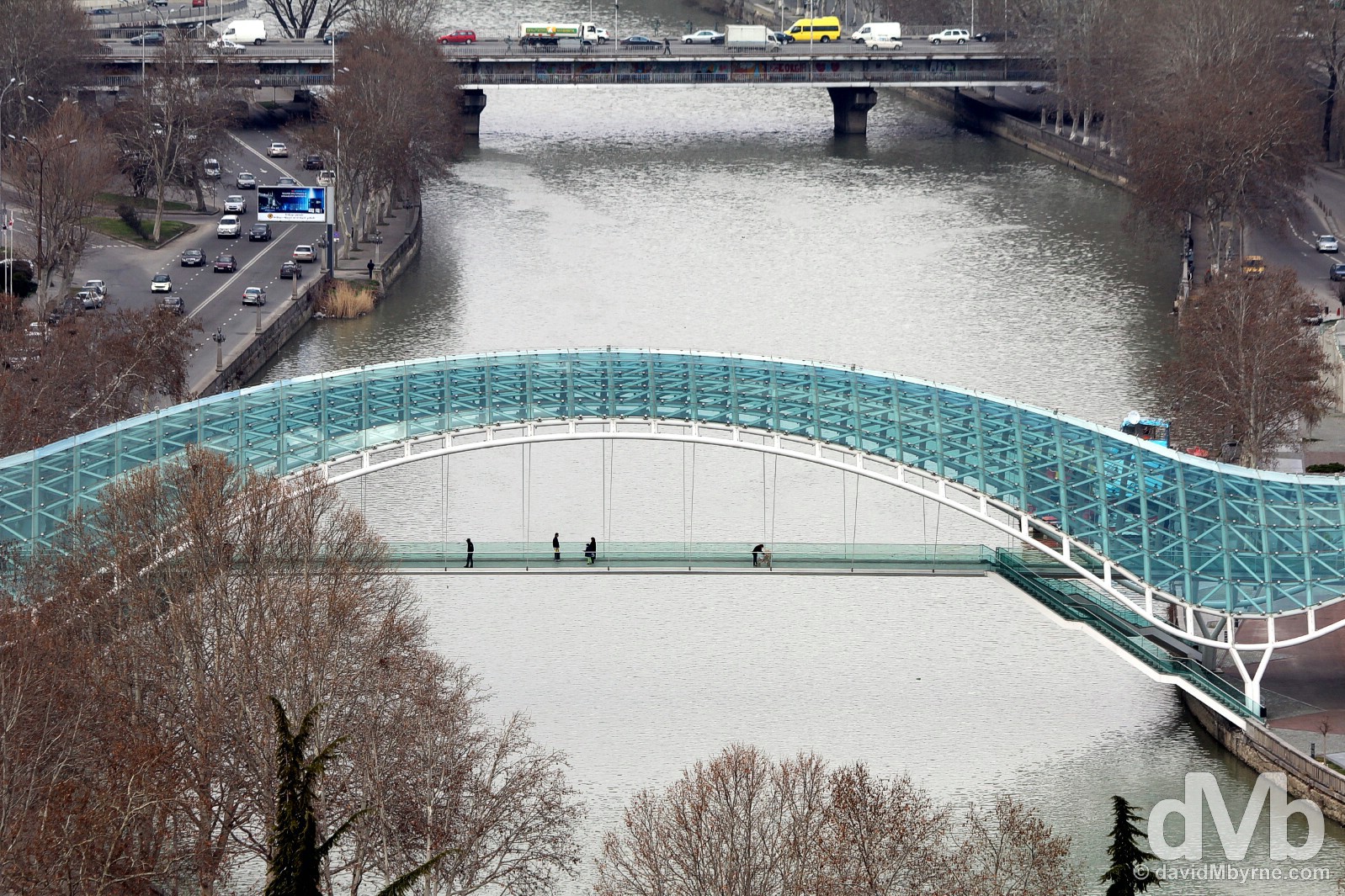
Opened in May 2010, Tbilisi’s Bridge of Peace boasts an interactive light system comprised of over 30,000 LED lights & 240 sensors. All of these combine to dance, transmitting, it is said, ‘the chemical makeup of the human body in Morse code’. One of the highlights of Tbilisi after dark, the bridge is billed by the country’s President, Mikheil Saakashvili, whose 21st-century, egg-shaped glass domed Presidential Palace overlooks the bridge, as a symbol of Georgia’s journey from the past to a better, brighter future. Tbilisi, Georgia. March 19, 2015.
Nariqala Fortress
The above picture was captured from afar, from atop the walls of the city’s iconic Nariqala Fortress, the city’s ancient citadel. It was first built back in the 4th century, when it was a Persian citadel, before being expanded to its present form by the Arabs in the 8th century. Perched on a hill high over Old Town Tbilisi and visible from all over the city, & especially at night when it’s brilliantly illuminated, the fortress these days is nothing more than a string of walls that offer sublime view down over modern-day Tbilisi.
Rustaveli Avenue
Tbilisi’s main artery, Rustaveli Avenue runs for 1.5 kilometres through the heart of the city, an elegant tree-lined, flower bed-infested avenue that was built in the 19th century and is named after Georgia’s most famous author, Shota Rustaveli. It connects the city’s two main squares, Freedom Square & Rustaveli Square, and is lined with churches (of course), museums & art galleries housed in an array of impressive buildings (the 1899-1901 baroque-cum-rococo National Theatre, the 1896 Moorish Opera & Ballet Theatre, & the hulking orange 1938-1953 Georgian Parliament are the standouts). All that said, it was the simple people watching that was the highlight of my strolls up & down Tbilisi’s main drag.
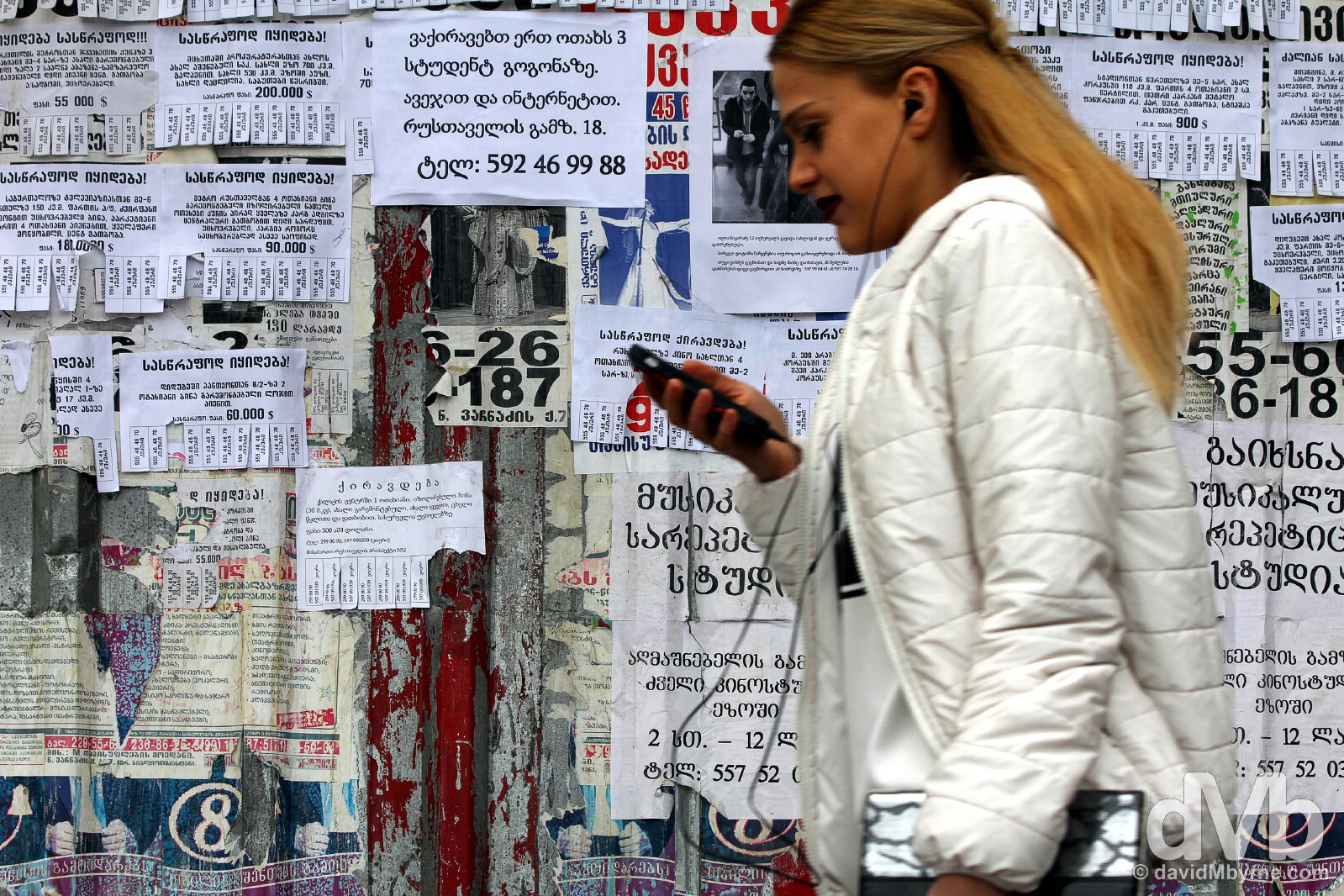
People watching on Rustaveli Avenue in central Tbilisi, Georgia. March 19, 2015.
Freedom Square (Tavisuplebis moedani) & Mother Georgia
The southern end of Rustaveli Avenue, and right on the edge of Tbilisi’s Old Town, is Freedom Square (Tavisuplebis moedani).
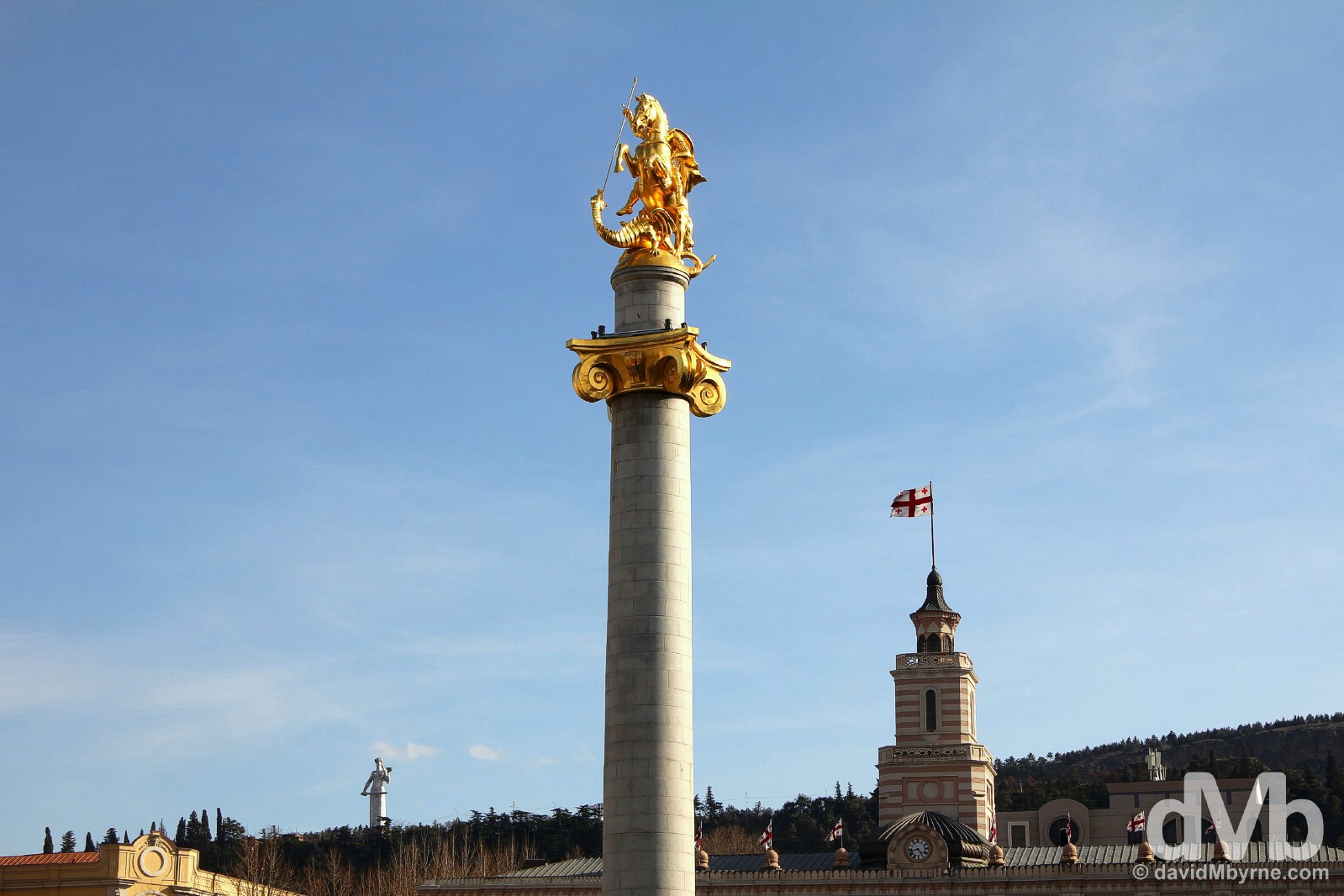
Freedom Square (Tavisuplebis moedani), more like a busy traffic circle, is dominated by a lofted statue of a mounted St George spearing a dragon. This blindingly golden structure replaced a Lenin statue that stood pride of place in the square until being toppled in 1990 (the square was know as Lenin Square during Soviet days). Also visible in the above picture is the Georgian flag-heavy Tbilisi City Hall, and on the hill in the distance, a short walk from Nariqala Fortress, the iconic Kartlis Deda (Mother Georgia) statue, a 20 metre-high aluminium statue of a women holding a cup of wine in one hand, symbolising friends, and a sword in the other, symbolising enemies. Built in 1958 for the 1500th anniversary of the city, it’s another symbol of the city that is visible for miles around. Freedom Square (Tavisuplebis moedani), Tbilisi, Georgia. March 23, 2015.
Tsminda Sameba (Holy Trinity Cathedral)
Probably Tbilisi’s most dominant structure is the massive Tsminda Sameba (Holy Trinity Cathedral), an unmissable city landmark and the largest Orthodox Church in Georgia & the second largest church in the Caucasus after the the Surp Grigor Lusavorich Cathedral in Yerevan, Armenia.
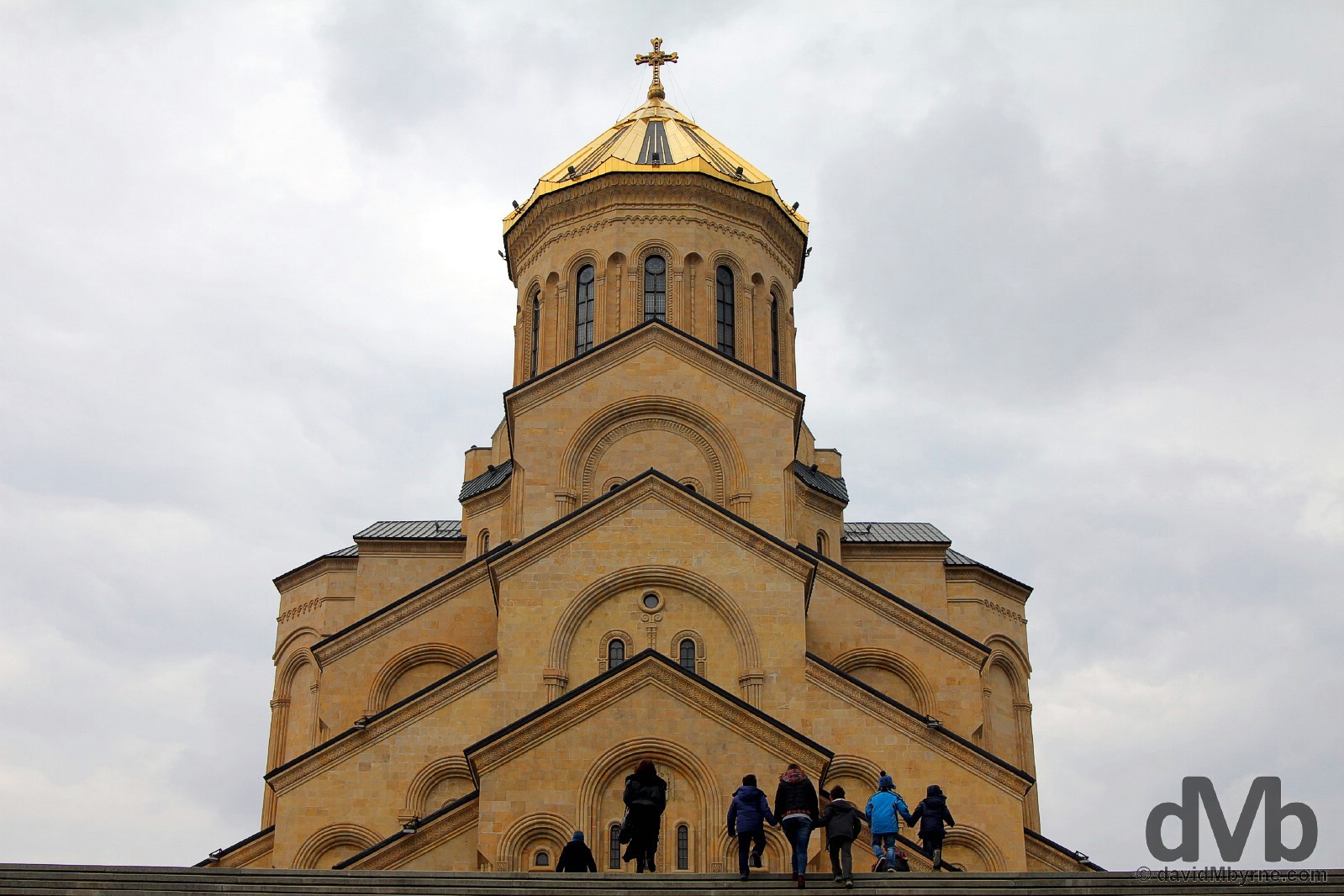
Climbing the steps fronting the massive Tsminda Sameba (Holy Trinity Cathedral) in Tbilisi. Consecrated in 2004 after a 10-year build, it was constructed in traditional Georgian architectural style – a cross church with distinctive drum & pointed dome, with this particular 84 metre-high dome topped by a gold-covered cross. Tbilisi, Georgia. March 19, 2015.
Georgian Churches
The Georgian Orthodox Church has seen a revival since the dark Soviet days, when all religious practice was outlawed, & today Georgian churches provide one of the quintessential symbols of the country, albeit not all on the mammoth scale of Tbilisi’s Tsminda Sameba (Holy Trinity Cathedral). A fusion of two church styles, the Roman-influenced rectangular basilica and the central-domed church, formed the elongated-cross church of the 12th & 13th centuries, Georgia’s golden age. Churches in this form are dotted all over the country, some in unbelievably lofty & isolated places, and even today churches are still built in this traditional style.
MESTIA
Mestia, Upper Svaneti ( ) || The Svan Heartland & Svan Towers
) || The Svan Heartland & Svan Towers
Geographically it’s not far from Tbilisi to the Georgian highland townlet of Mestia, located at an altitude of 1400 metres in the northwest Svaneti region of the country. But, & outside of the summer high season when you can fly between the two locations in less than an hour, it’ll take a good chunk of time to get here from the capital; it took me 12 hours, most of which were spent on the overnight train from Tbilisi to Zugdidi in the west of the country and only a few kilometres from the border with Abkhazia, the 9,000 km² partially recgonised state – by Russia & a handful of others – that Georgia lost control of as a result of the 1992-1993 War in Abkhazia. It was from there that I solicited a minibus to take me the rest of the way into remote, high Caucasus mountain country, a UNESCO World Heritage listed land of spectacular scenery, cows, & picturesque villages dotted with thousand-year-old defensive stone towers. This is also the home of the Svans, an indigenous people who have lived here for centuries & who are trying to keep age-old traditions alive in the face of burgeoning tourism. The remoteness of this region – this was somewhere never tamed by any ruler, foreign or otherwise – means the Svans, & while they they bear an ethnic relationship to their fellow Georgians, have created a language & lifestyle that is all their own.
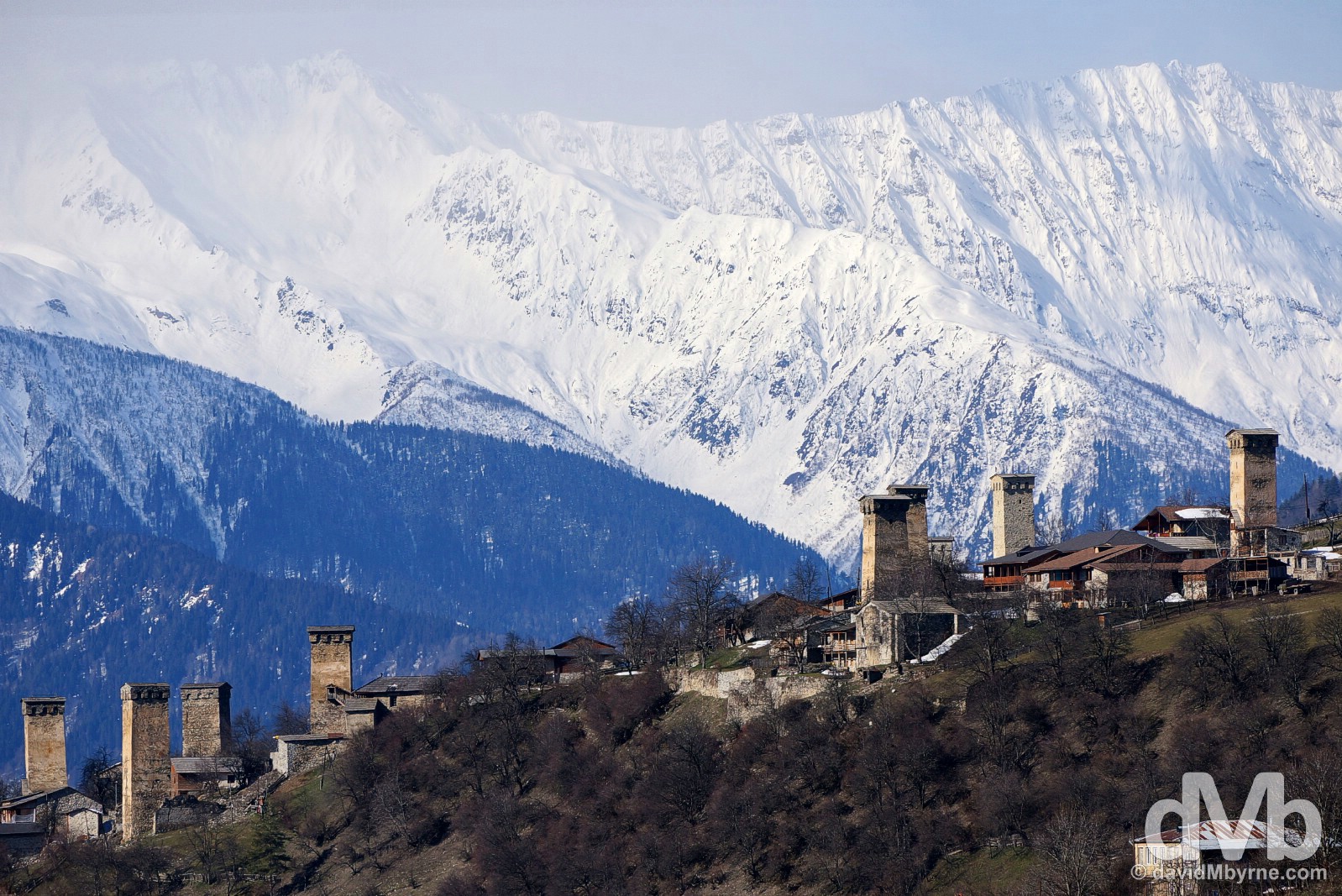
Svan Towers in the highland town of Mestia in the Caucasus mountains of northwest Georgia. A trip into the High Caucasus of Georgia is to see the country at its spectacular, jaw-dropping best. This mighty range forms a natural border with Russia and contains Europe’s highest peak, 5,642-metre-high Mount Elbrus I’d guesstimate only some 30-40 kilometres as the crow flies from here on the Russian side of the divide. The peaks surrounding the village of Mestia itself rise to over 4,000 metres creating, and coupled it the village’s array of stone Svan Towers, a rather picturesque backdrop. Mestia, Upper Svaneti, Georgia. March 21, 2015.
– UNESCO commenting on Upper Svaneti
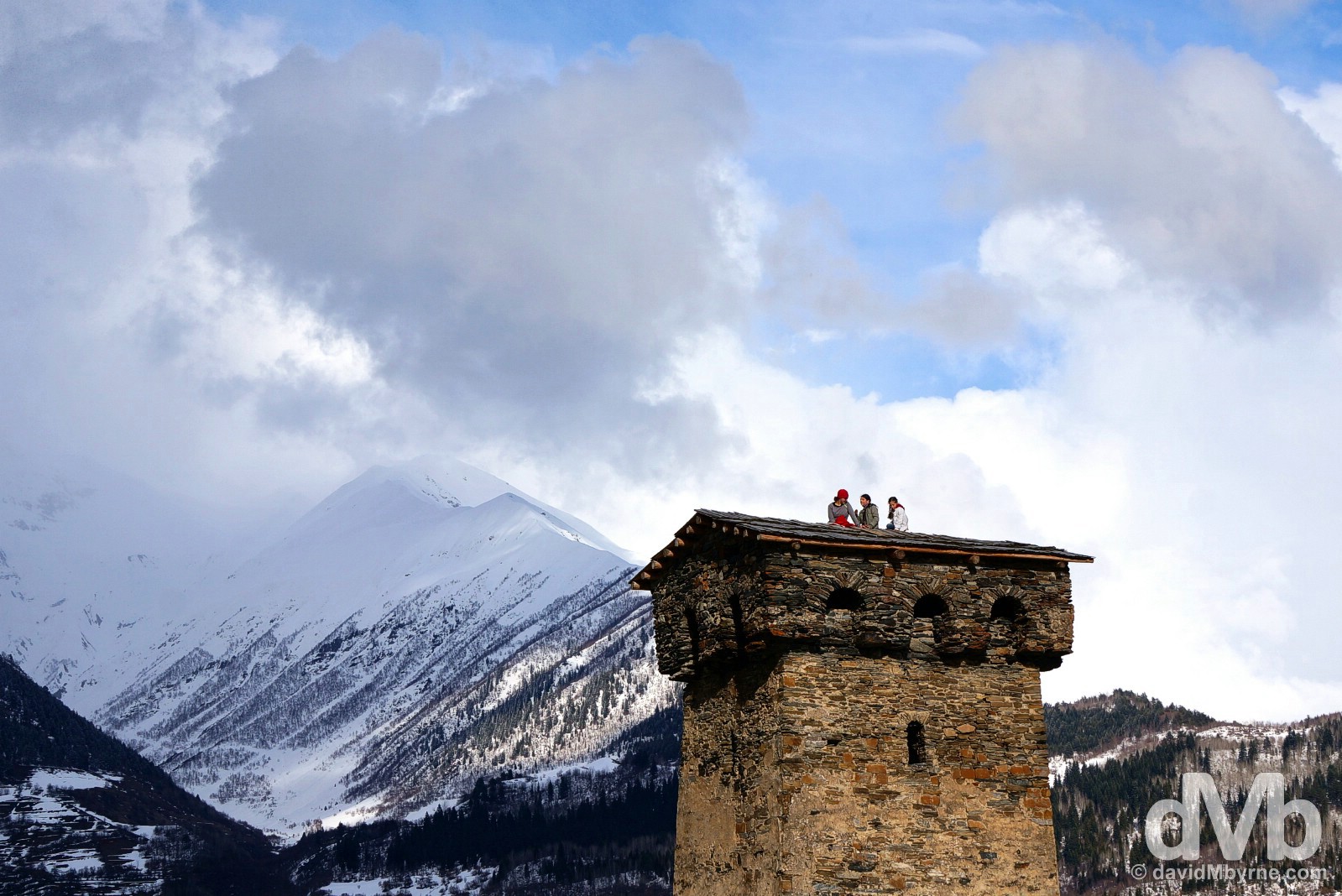
Sitting atop one of the distinctive Svan Towers in Mestia. The region’s emblem, the towers symbolise both the area’s resistance to invaders and inspires local pride. Most were built between the 9th and 13th centuries, though it is estimated that the oldest date as far back as the 1st Century BC. Built out of fear of attack, they were designed to shelter villages in times of invasion, mostly from Byzantine and Russian invaders, but were also used during times of local blood feuds. Some 175 of them remain today, dotted across the region in both inhabited and abandoned villages. Mestia, Upper Svaneti, Georgia. March 21, 2015.
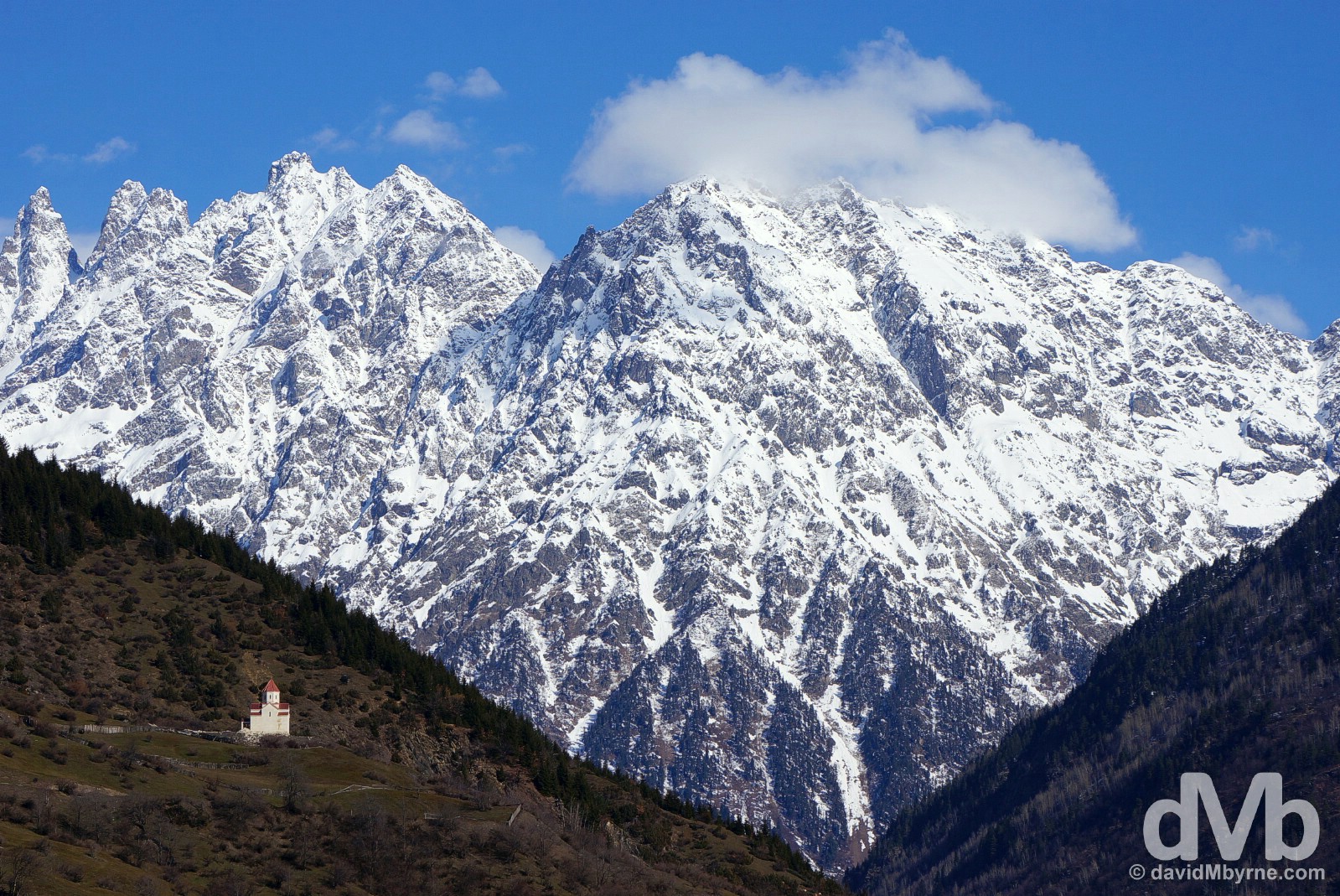
Nature 1:0 Dave
The Upper Svaneti region is a trekkers nirvana with a popular excursion being a multi-day walk from Mestia to Ushguil, Europe’s highest inhabited village. The 60+ kilometre walk through lush Upper Svaneti valleys & over mountain passes is a highlight of a trip to the region. Just not this time of year; snow means most treks are only possible in the walking season (June through September). However, on this particular day I still tried to hike to a glacier. I got most of the way there but ultimately a slow slog wading through crown jewels-high virgin snow, coupled with the fear of falling into some crevasse never to be heard from again, saw me concede defeat & retreat back down the valley seen here, the Mestiachala Valley outside Mestia close to the entrance of which you’ll find a typically precariously perched Georgian church. I’ll give you that one, nature. Oh, and thanks for the vistas. The entrance to the Mestiachala Valley outside the highland town of Mestia in the Caucasus Mountains in northwest Georgia. March 22, 2015.
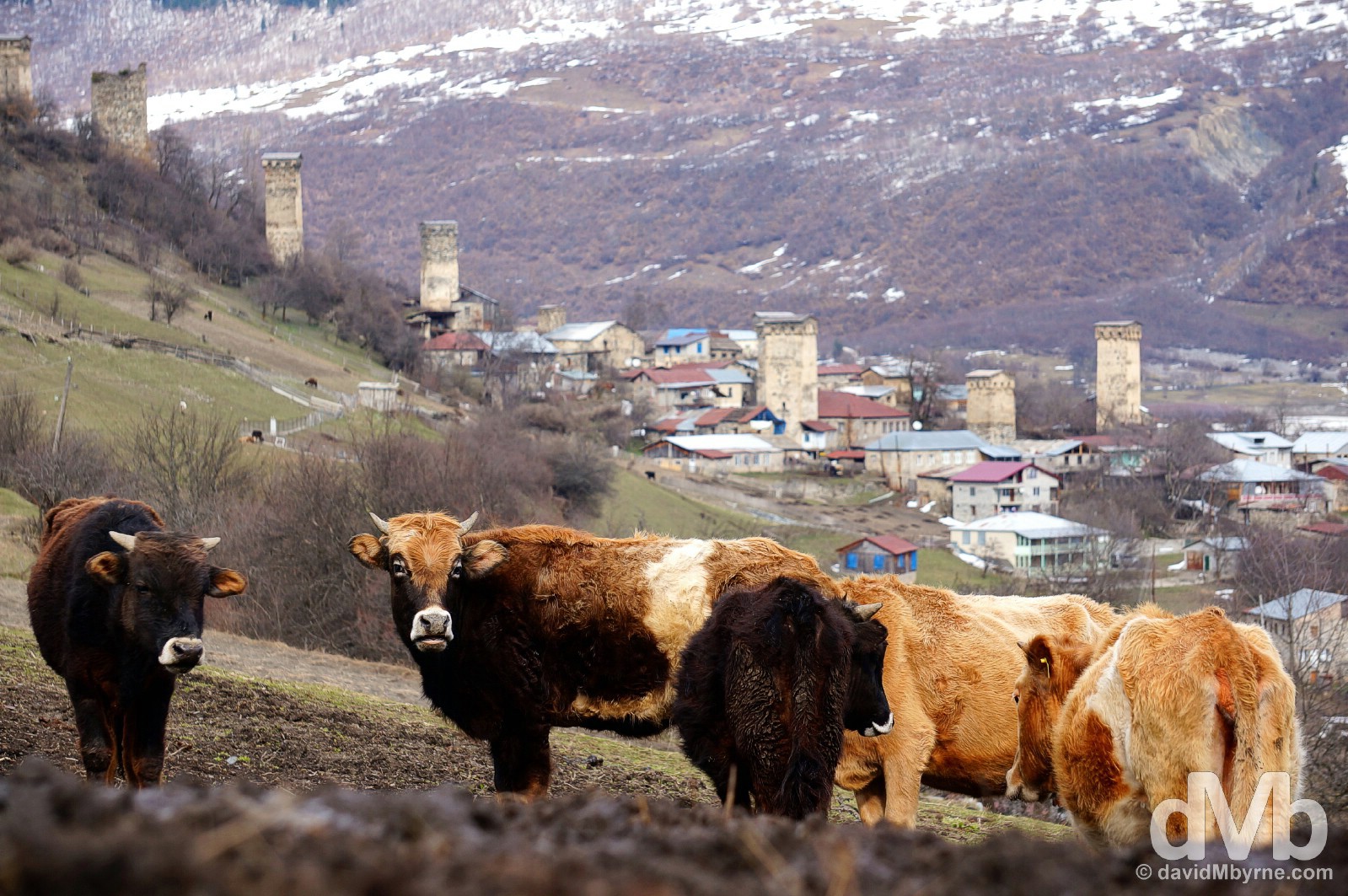
As much a part of the Upper Svaneti experience as jaw-dropping scenery, hiking & stone towers, cows are not just confined to the fields in & around Upper Svaneti villages like Mestia. They roam everywhere, so much so that at times I felt like I was in India. Mestia, Upper Svaneti, Georgia. March 21, 2015.
TSMINDA SAMEBA (HOLY TRINITY) / GERGETI TRINITY CHURCH
The Tsminda Sameba (Holy Trinity) Church, Stepantsminda ( )
)
I wasn’t done with Georgia’s great outdoors. Nor was I done with its churches. I wanted more so, and after leaving Georgia to spend a few days in neighbouring Armenia, I returned & extended my stay in the country by one more day in order to have one more night among the scenery, clean air & churches of the High Caucasus. And in doing so I may just have saved the best for last.

HOLY TRINITY CHURCH || This is the reason I extended my time in Georgia, & in the Caucasus, by a day. It’s also the reason why I dragged myself to within a few kilometres of the Georgia/Russia border, not to mention the disputed border with the partially recgonised state of South Ossetia (the road from Tbilisi in the south parallels the demarcation line for a lot of its 150-kilometre journey north). The iconic 14th century Georgian Orthodox Tsminda Sameba (Holy Trinity) Church, also called the Gergeti Trinity Church, sits perched at a height of 2,100-plus metres above the village of Stepantsminda, itself perched at the end of the so-called Georgian Military Highway, a winding mountain road connecting the capital to the Russian border high in the Georgian Caucasus. This weathered church more any other in the country demonstrates the Georgian penchant for putting places of worship in such lofty & isolated locations with thanks due in no small part to the stunning backdrop – ably provided by 5,047-metre-high Mount Kazbek, eastern Georgia’s highest peak – for ensuring that this church in particular has become a defining symbol of Georgia. Once accessible via a Soviet-supplied cable car from Stepantsminda, one destroyed by the locals who claimed it defiled their sacred place (& good on them), the church is easily accessible via a stiff 5-kilometer uphill hike, the views of the stunning alpine environment on offer ample reward for each and every bead of sweat the hike demands. I couldn’t leave Georgia without laying eyes on this. I just couldn’t and now that I have I’m good to go. The Tsminda Sameba (Holy Trinity) Church above the village of Stepantsminda, northern Georgia. March 28, 2015.
